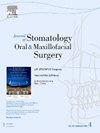评估最大张口度测量技术的再现性和有效性。
IF 1.8
3区 医学
Q2 DENTISTRY, ORAL SURGERY & MEDICINE
Journal of Stomatology Oral and Maxillofacial Surgery
Pub Date : 2024-10-01
DOI:10.1016/j.jormas.2024.102107
引用次数: 0
摘要
目的:最大张口度(MMO)受限是口腔(癌症)手术的常见并发症。右中切牙之间的测量被认为是评估最大口腔张力的黄金标准,但也有人指出该方法会高估无牙颌患者的最大口腔张力。本研究旨在评估四种 MMO 技术的可重复性和有效性,并确定它们对剩余牙列的依赖程度:材料和方法:对连续的混合牙列患者记录了四种测量 MMO 的方法。使用布兰-阿尔特曼图比较了不同测量方法之间的一致性。为了研究每种方法的可重复性,对两名临床医生在两个疗程中进行的测量计算了疗程间、观察者间和观察者内的可靠性。根据患者的牙齿情况分为两组:(A) 至少缺失一颗右中切牙的患者;(B) 有两颗右中切牙的患者:结果:除一个类内相关系数(ICC)外,所有类内相关系数均显示出极佳的重现性(ICC > .9)。口内 MMO(iMMO)和校正口内 MMO(ciMMO)法的 ICC 值最高。只有口内运动范围(iROM)法的两个亚组的 MMO 之间存在明显关系(p=.010*):研究结果表明,目前测量 MMO 的黄金标准并不能充分考虑右中切牙缺失的情况。建议在未来的 MMO 临床试验中采用两种方法,其中包括对缺失切牙的矫正。本文章由计算机程序翻译,如有差异,请以英文原文为准。
Evaluating the reproducibility and validity of maximal mouth opening measurement techniques
Objectives
A limitation of the maximal mouth opening (MMO) is a frequent complication of oral (cancer) surgery. The measurement between the right central incisors is considered the golden standard for assessing MMO, although it has been noted to overestimate MMO in edentulous patients. This study aims to evaluate the reproducibility and validity of four MMO techniques and to determine the extent to which they are dependent on the remaining dentition.
Materials and Methods
Four methods for capturing the MMO were recorded in consecutive patients with mixed dentition. The degree of agreement between the different measurement methods was compared using Bland-Altman plots. To investigate the reproducibility of each method, intersession, interobserver and intraobserver reliability were calculated for measurements performed by two clinicians across two sessions. Two subgroups were created based on dentition: (A) cases missing at least one right central incisor, and (B) patients with both right central incisors present.
Results
All but one intraclass correlation coefficient (ICC) demonstrated excellent reproducibility (ICC > 0.9). The highest ICC values were found for the intraoral MMO(iMMO) and corrected intraoral MMO(ciMMO) method. A significant relationship between the MMO in both subgroups was identified only for the intraoral Range of Motion (iROM) method (p=.010*).
Conclusion
The findings suggest that the current golden standard for measuring MMO does not adequately account for the absence of the right central incisor(s). Two of the proposed methods, which include corrections for missing incisors, should be incorporated into future clinical trials on MMO.
求助全文
通过发布文献求助,成功后即可免费获取论文全文。
去求助
来源期刊

Journal of Stomatology Oral and Maxillofacial Surgery
Surgery, Dentistry, Oral Surgery and Medicine, Otorhinolaryngology and Facial Plastic Surgery
CiteScore
2.30
自引率
9.10%
发文量
0
审稿时长
23 days
 求助内容:
求助内容: 应助结果提醒方式:
应助结果提醒方式:


